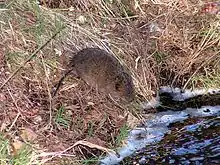Arvicola
The water voles are large voles in the genus Arvicola. They are found in both aquatic and dry habitat through Europe and much of northern Asia. A water vole found in Western North America was historically considered a member of this genus, but has been shown to be more closely related to members of the genus Microtus.[1][2] Head and body lengths are 12–22 cm, tail lengths are 6.5–12.5 cm, and their weights are 70–250 g. The animals may exhibit indeterminate growth. They are thick-furred and have hairy fringes on their feet that improve their swimming ability.
| Water voles Temporal range: Early Pleistocene - Recent | |
|---|---|
 | |
| Arvicola amphibius | |
| Scientific classification | |
| Kingdom: | Animalia |
| Phylum: | Chordata |
| Class: | Mammalia |
| Order: | Rodentia |
| Family: | Cricetidae |
| Subfamily: | Arvicolinae |
| Tribe: | Arvicolini |
| Genus: | Arvicola Lacépède, 1799 |
| Species | |
|
Arvicola amphibius | |
Species
- European (or northern) water vole (A. amphibius or A. terrestris)
- Southwestern (or southern) water vole (A. sapidus)
- Montane water vole (A. scherman)
References
- Conroy, C. J. and J. A. Cook. 2000. Molecular systematics of a Holarctic rodent (Microtus: Muridae). Journal of Mammalogy, 81:344-359.
- Musser, G. G. and M. D. Carleton. 2005. Superfamily Muroidea. pp. 894–1531 in Mammal Species of the World a Taxonomic and Geographic Reference. D. E. Wilson and D. M. Reeder eds. Johns Hopkins University Press, Baltimore.
Further reading
- Nowak, R. M. 1999. Walker's Mammals of the World, Vol. 2. Johns Hopkins University Press, London.
- Townsend, C., Begon, M. and Harper, J.L. 2003. Essentials of Ecology: second edition. Blackwell Publishing, Oxford.
This article is issued from Wikipedia. The text is licensed under Creative Commons - Attribution - Sharealike. Additional terms may apply for the media files.